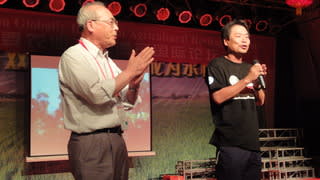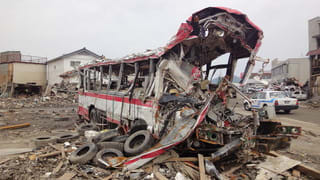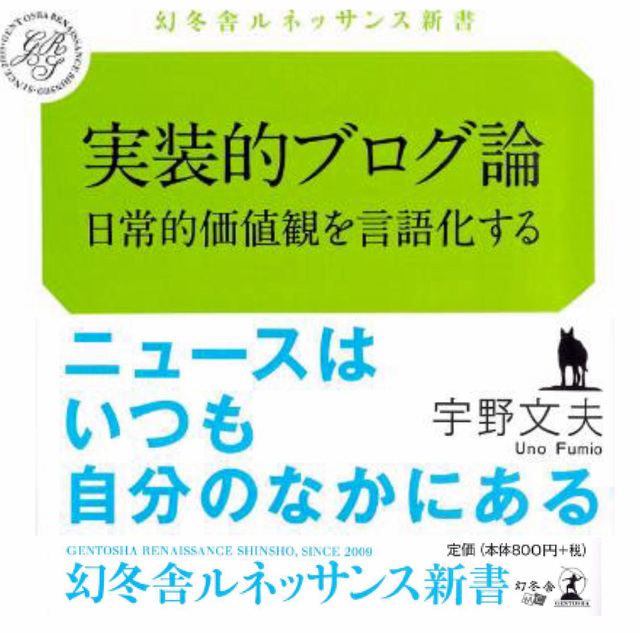
国連食糧農業機関(FAO、本部ローマ)のGIAHS事務局長、パルビス・クーハフカン氏が17日、認証セレモニーに出席のため能登入りした。パルビス氏が能登を訪問したは昨年6月以来、2度目となる。前回は金沢でのシンポジウム出席のため、ついでに能登の里山里海の視察で訪れた。金沢大学の能登学舎では、環境配慮型農業の社会人養成コース「能登里山マイスター養成プログラム」のカリキュラムと水田での生物多様性実習などについて説明を受け、それについて鋭く質問を浴びせた。さらに、実際に能登の田んぼで採集され昆虫の標本を食い入るように見ていた=写真=。パルビス氏が説く農業と環境の共存という主張は、本物だとこのとき私自身実感した。いまにして思えば、彼にとってもこのときの能登視察の第一印象が鮮明に残ったに違いない。言葉の端々に「N0TO」が出てくる。
パルビス氏は能登空港で開催された認証セレモニーで「GIAHSは過去についてではなく、未来についてがテーマである。これが終わりではなく、始まりなのだ」と語った=写真・下=。氏の演説を録音起こしした早業の女史がいる。その原稿をいただいたので、そのまま掲載する。

Honorable Governor of Ishikawa Prefecture, Mayor of Noto, Proffessor Takeuchi, members of government, and local community, colleagues and friends, It is an honor and privilege for me to represent the (聞き落とし) of FAO, food and agricultural organization of the United Nations, in this very happy day of celebration of designation of noto peninsula as a globally important agricultural heritage system, or world agricultural heritage.
Dear friends and colleagues, please note Word Agricultural Heritage is not about the past but about the future.
Humanity faces many challenges: financial and economic crises, food and security and poverty, environmental degradation, climate change, and balance population dynamics and many other challenges.
The foundations of our modern development patterns are questioned and globalization is creating many distortions in local values, and direction of our future generation is questioned.
As many scientists and others agree these days, we need to go back to our basic principle to build a new future.
GIAHS is about pillars of sustainability--ecological, economical, and social. It is about local food production and consumption, empowerment of local community, and reduction of our carbon footprint.
It’s about conservation of sustainable utilization of our biodiversity, using our local knowledge to manage and enhance our capacity to live in harmony with nature.
It is about the promotion of cultural diversity, and our deep beliefs and values, and it is about our aesthetic values and conservation of our landscapes or our satoyama.
Becoming a World Agricultural Heritage is both a privilege, but particularly, it is a responsibility.
The first step in working as members of GIAHS community, is stake-holder consultation, and prior informed consent.
This principle is one of the major principles of the convention on biological diversity.
This means, politicians, decision makers, members of the government need to discuss, and decide together with local communities and citizens.
The second step is the mainstreaming of the principles of GIAHS in our policies and practices.
This means cherishing our biodiversity, cherishing our cultural diversity, taking care of our indigenous knowledge, and cherishing our aesthetic values.
It is about empowering local communities, and preparing and assisting them in providing new opportunities, such as labeling, such as eco-tourism, such as installation of young people, and preparation of livelihood order.
I’m very pleased that big nations such as Japan, China, India, and Chile, and many countries are cherishing in agricultural heritage, but this is not an automatic recognition.
We need to identify model farms and model farmers, who are integrating all these principles―principles of GIAHS―into their practices and policies.
And by providing capacity building and helping these communities that everybody could include their livelihood system and crises.
We need a green agriculture in an era of green economy.
I’m confident that we will work together in achieving these objectives and goals, and our children and youngest generation will come back and join our effort in this happiness.
Thank you very much.
⇒18日(土)・金沢の天気 くもり
 【翻訳文】 石川県知事、能登の市長町長、武内(和彦)教授、政府関係者や地域の皆さん、そして友人知人の皆さんの前で、能登半島が世界的に重要な農業遺産システムとして世界農業遺産に登録される大変素晴らしいお祝いの日に、FAO(国連食糧農業機関)を代表してお話しできるのは、私にとって光栄で名誉なことです。
【翻訳文】 石川県知事、能登の市長町長、武内(和彦)教授、政府関係者や地域の皆さん、そして友人知人の皆さんの前で、能登半島が世界的に重要な農業遺産システムとして世界農業遺産に登録される大変素晴らしいお祝いの日に、FAO(国連食糧農業機関)を代表してお話しできるのは、私にとって光栄で名誉なことです。 次の段階は、GIAHSの原則を地域の方針と実践の中に取り入れることです。これは、生物多様性や文化的多様性を大切にし、地域固有の知識を保護し、美意識を大切にすることを意味します。それはすなわち、地域社会の強化であり、ブランド化やエコツーリズム、若者の移住やその生活といった新たな機会を提供するために、地域社会を整備・支援することです。
次の段階は、GIAHSの原則を地域の方針と実践の中に取り入れることです。これは、生物多様性や文化的多様性を大切にし、地域固有の知識を保護し、美意識を大切にすることを意味します。それはすなわち、地域社会の強化であり、ブランド化やエコツーリズム、若者の移住やその生活といった新たな機会を提供するために、地域社会を整備・支援することです。









 国連食糧農業機関(FAO、本部ローマ)のGIAHS事務局長、パルビス・クーハフカン氏が17日、認証セレモニーに出席のため能登入りした。パルビス氏が能登を訪問したは昨年6月以来、2度目となる。前回は金沢でのシンポジウム出席のため、ついでに能登の里山里海の視察で訪れた。金沢大学の能登学舎では、環境配慮型農業の社会人養成コース「能登里山マイスター養成プログラム」のカリキュラムと水田での生物多様性実習などについて説明を受け、それについて鋭く質問を浴びせた。さらに、実際に能登の田んぼで採集され昆虫の標本を食い入るように見ていた=写真=。パルビス氏が説く農業と環境の共存という主張は、本物だとこのとき私自身実感した。いまにして思えば、彼にとってもこのときの能登視察の第一印象が鮮明に残ったに違いない。言葉の端々に「N0TO」が出てくる。
国連食糧農業機関(FAO、本部ローマ)のGIAHS事務局長、パルビス・クーハフカン氏が17日、認証セレモニーに出席のため能登入りした。パルビス氏が能登を訪問したは昨年6月以来、2度目となる。前回は金沢でのシンポジウム出席のため、ついでに能登の里山里海の視察で訪れた。金沢大学の能登学舎では、環境配慮型農業の社会人養成コース「能登里山マイスター養成プログラム」のカリキュラムと水田での生物多様性実習などについて説明を受け、それについて鋭く質問を浴びせた。さらに、実際に能登の田んぼで採集され昆虫の標本を食い入るように見ていた=写真=。パルビス氏が説く農業と環境の共存という主張は、本物だとこのとき私自身実感した。いまにして思えば、彼にとってもこのときの能登視察の第一印象が鮮明に残ったに違いない。言葉の端々に「N0TO」が出てくる。 その歌声は懐かしい響きがした。北京で開かれているGIAHS(世界重要農業資産システム)国際フォーラムの11日夜の懇親会でのこと。中国ハニ族の人たちがステージに上がり土地の民謡を歌った後、能登半島・七尾市から武元文平市長に随行してきた市職員が祝い歌「七尾まだら」を披露した=写真=。武元氏もステージに上がり手拍子を打った。朗々と歌うそのシーンは感動ものだった。会場が沸いた。すると、すかさずケニア・マサイ族、ナイジェリアと参加者が続々とステージに上がり土地の歌を披露した。佐渡市長の高野宏一郎氏は「佐渡おけさ」を歌い、職員2人が踊った。ステージは国際民謡大会の様相だった。国際親善とは本来このような在り様なのだろう。
その歌声は懐かしい響きがした。北京で開かれているGIAHS(世界重要農業資産システム)国際フォーラムの11日夜の懇親会でのこと。中国ハニ族の人たちがステージに上がり土地の民謡を歌った後、能登半島・七尾市から武元文平市長に随行してきた市職員が祝い歌「七尾まだら」を披露した=写真=。武元氏もステージに上がり手拍子を打った。朗々と歌うそのシーンは感動ものだった。会場が沸いた。すると、すかさずケニア・マサイ族、ナイジェリアと参加者が続々とステージに上がり土地の歌を披露した。佐渡市長の高野宏一郎氏は「佐渡おけさ」を歌い、職員2人が踊った。ステージは国際民謡大会の様相だった。国際親善とは本来このような在り様なのだろう。 11日午前9時から開かれた認証式で、能登半島の「能登の里山里海」と、佐渡市の「トキと共生する佐渡の里山」が正式にGIAHS(通称:世界農業遺産)の登録が認められ、授与式があった。武元氏は「大変名誉ある認証をいただき、とてもうれしい。日本の中でも遅れているといわれてきた地域が評価された。豊かな自然、文化、農林水産業が営々と続いている。先人の営みがまとめて評価された。今後は能登と佐渡が手を携えて、環境に配慮した農林水産業の地域づくりにまい進したい」と語った。
11日午前9時から開かれた認証式で、能登半島の「能登の里山里海」と、佐渡市の「トキと共生する佐渡の里山」が正式にGIAHS(通称:世界農業遺産)の登録が認められ、授与式があった。武元氏は「大変名誉ある認証をいただき、とてもうれしい。日本の中でも遅れているといわれてきた地域が評価された。豊かな自然、文化、農林水産業が営々と続いている。先人の営みがまとめて評価された。今後は能登と佐渡が手を携えて、環境に配慮した農林水産業の地域づくりにまい進したい」と語った。 GIAHSはFAOが2002年に設けた制度だ。伝統的な農業の営みや生物多様性が守られた重要な土地利用システムを登録し、農山漁村の持続的な発展を支援する仕組みで、ペルー、チリ、中国、フィリピン、チュニジア、アルジェリア、ケニア、タンザニアのパイロット地区8件が登録されている。もう少し詳しくこの制度を説明すると、1)食料安全保障と人間の福利を確保しながら、農業のシステムと生物多様性を育み適応させる、2)生物多様性と伝統的な知識を元の場所で保護するのと同時に、保護的な政府の政策やインセンティブを支援する、3)食料への権利、文化的な多様性、地元コミュニティーやその地域の人々の成果を評価し認識する、4)天然資源の管理のため、遺伝資源を元の場所で保護するという考え方に、さらに伝統知識や地元の慣例を統合していくというアプローチが必要であることを明確にする(「FAOホームページ」より)。簡単な話でいえば、共通の視点で、農山漁村の国際ネットワークをつくろうとうことなのだ。
GIAHSはFAOが2002年に設けた制度だ。伝統的な農業の営みや生物多様性が守られた重要な土地利用システムを登録し、農山漁村の持続的な発展を支援する仕組みで、ペルー、チリ、中国、フィリピン、チュニジア、アルジェリア、ケニア、タンザニアのパイロット地区8件が登録されている。もう少し詳しくこの制度を説明すると、1)食料安全保障と人間の福利を確保しながら、農業のシステムと生物多様性を育み適応させる、2)生物多様性と伝統的な知識を元の場所で保護するのと同時に、保護的な政府の政策やインセンティブを支援する、3)食料への権利、文化的な多様性、地元コミュニティーやその地域の人々の成果を評価し認識する、4)天然資源の管理のため、遺伝資源を元の場所で保護するという考え方に、さらに伝統知識や地元の慣例を統合していくというアプローチが必要であることを明確にする(「FAOホームページ」より)。簡単な話でいえば、共通の視点で、農山漁村の国際ネットワークをつくろうとうことなのだ。 GIAHSは、Globally Important Agricultural Heritage Systems(GIAHS). 「世界農業遺産」とも呼ばれる「世界重要農業資産システム」のことだ。GIAHSは地域の環境を生かした伝統的な農法や、生物多様性が守られた土地利用システムを後世に残し、また世界に広めることを目的に、FAOが2002年に設立した。現在、世界遺産にも登録されているフィリピンのイフガオ州の棚田など8件が認定されている。
GIAHSは、Globally Important Agricultural Heritage Systems(GIAHS). 「世界農業遺産」とも呼ばれる「世界重要農業資産システム」のことだ。GIAHSは地域の環境を生かした伝統的な農法や、生物多様性が守られた土地利用システムを後世に残し、また世界に広めることを目的に、FAOが2002年に設立した。現在、世界遺産にも登録されているフィリピンのイフガオ州の棚田など8件が認定されている。 フォーラムの討議はきのう9日から始まり、きょう午前、申請者の武元文平氏(石川県七尾市長)と高野宏一郎氏(新潟県佐渡市長)がそれぞれ能登と佐渡の農業を中心とした歴史や文化、将来展望などGIAHS申請の背景を英語で紹介した。その内容を要約する。能登の七尾市など4市4町は、1300年の歴史を持つため池と棚田の稲作、沿岸部での製塩技術などを「里山里海」「半農半漁」の生業(なりわい)、ユネスコの無形文化遺産として登録されている農耕儀礼「田の神をもてなすアエノコト」を申請書に盛り込んだ。武元氏は「能登の8つの市と町がいっしょになって農林水産業をベースとした持続可能な地域づくりを行いたい」「GIAHS認定を契機として先祖から引き継いだ生物多様性や自然環境を守り、新たな価値を創造して次世代につなげたい」と述べた。
フォーラムの討議はきのう9日から始まり、きょう午前、申請者の武元文平氏(石川県七尾市長)と高野宏一郎氏(新潟県佐渡市長)がそれぞれ能登と佐渡の農業を中心とした歴史や文化、将来展望などGIAHS申請の背景を英語で紹介した。その内容を要約する。能登の七尾市など4市4町は、1300年の歴史を持つため池と棚田の稲作、沿岸部での製塩技術などを「里山里海」「半農半漁」の生業(なりわい)、ユネスコの無形文化遺産として登録されている農耕儀礼「田の神をもてなすアエノコト」を申請書に盛り込んだ。武元氏は「能登の8つの市と町がいっしょになって農林水産業をベースとした持続可能な地域づくりを行いたい」「GIAHS認定を契機として先祖から引き継いだ生物多様性や自然環境を守り、新たな価値を創造して次世代につなげたい」と述べた。 その旗をよく見ると、「祝 大漁」の「祝」の文字を別の布で覆い、「祈」を書き入れたものも数枚あった=写真=。おそらく、市民有志がこの大漁旗の持ち主と話し合いの上で「祈 大漁」としたのであろう。漁船は使えず、漁に出たくとも出れない、せめて祈るしかない、あるいは亡き漁師仲間の冥福を祈ったのかもしれない。持ち主のそんな気持ちが伝わってきた。
その旗をよく見ると、「祝 大漁」の「祝」の文字を別の布で覆い、「祈」を書き入れたものも数枚あった=写真=。おそらく、市民有志がこの大漁旗の持ち主と話し合いの上で「祈 大漁」としたのであろう。漁船は使えず、漁に出たくとも出れない、せめて祈るしかない、あるいは亡き漁師仲間の冥福を祈ったのかもしれない。持ち主のそんな気持ちが伝わってきた。 公園から港方向に緩い坂を下り、カーブを曲がると焼野原の光景が広がる。気仙沼は震災と津波、そして火災に見舞われた。漁船が焼け、町が燃え、津波に洗われガレキと化した街となっている。リアス式海岸の入り江であったため、勢いを増した津波が石油タンクを流し、数百トンものトロール漁船をも陸に押し上げた=写真=。以前見た関東大震災の写真とそっくりだ。「天変地異」という言葉が脳裏をよぎった。今回の地震と津波は「想定外だった」という言葉をメディアを通じてよく聞く。よく考えれば、1923年9月1日に関東大震災を経験しているわれわれ日本にとって、「想定外」という言葉は死語に近いようなものだった。100年の間に想定外が2度起こることはありうるのだろうか。自らの責任を回避するために使っている、あるいは使っていただけなのだ。
公園から港方向に緩い坂を下り、カーブを曲がると焼野原の光景が広がる。気仙沼は震災と津波、そして火災に見舞われた。漁船が焼け、町が燃え、津波に洗われガレキと化した街となっている。リアス式海岸の入り江であったため、勢いを増した津波が石油タンクを流し、数百トンものトロール漁船をも陸に押し上げた=写真=。以前見た関東大震災の写真とそっくりだ。「天変地異」という言葉が脳裏をよぎった。今回の地震と津波は「想定外だった」という言葉をメディアを通じてよく聞く。よく考えれば、1923年9月1日に関東大震災を経験しているわれわれ日本にとって、「想定外」という言葉は死語に近いようなものだった。100年の間に想定外が2度起こることはありうるのだろうか。自らの責任を回避するために使っている、あるいは使っていただけなのだ。 こうした日本のメディアに在り様について、金沢大学の学生たちに考えてもらおうとアンケートを実施した(5月24日)。前回のコラムでも紹介したように、「現状でよい」が154人、「見直してもよい」が81人だった。
こうした日本のメディアに在り様について、金沢大学の学生たちに考えてもらおうとアンケートを実施した(5月24日)。前回のコラムでも紹介したように、「現状でよい」が154人、「見直してもよい」が81人だった。




